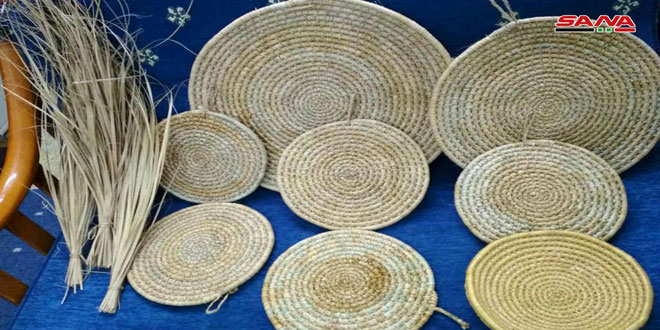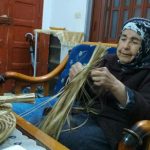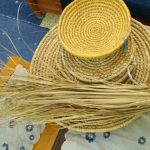Lattakia, SANA_ With the great development of our societies and the appearance of plastic, metal and glass utensils that meet the requirements of modern life, the use of straw trays for decorative purposes has been limited to certain villages and rural areas that still preserve the straw industry which is inherited by successive generations.
Straw industry or straw weaving is an ancient folk art that has retained its originality over the years and is widely available in popular markets, heritage museums and handicraft shows.
Mrs. Lamia Madi, who is over 80 years old, is eagerly waiting for the harvest season every year to start collecting bundles of wheat and oatmeal spikes and practicing her profession inherited by her mother which became her favorite pastime in the long times she spends in her home .
Straw harvested manually is the best material for weaving but it should be harvested at different time so that it would have shades varying from green to bright yellow.
Straw is dried, cleaned and soaked in hot water and after all it becomes more flexible and elastic.
In the past craftsmen frequently used straw dyed with natural colorants. It was boiled in water together with onion peels to intensify its yellow color or with alder cones or oak bark which made it brown.
Permanent travel between the provinces, due to Madi’s husband’s work, did not affect her passion of the straw weaving.
After a 25-year hiatus, she returned to work; she holds the straw with agility and moves her fingers quickly as if she did not leave this interesting work for a moment.
Madi, who lives in al-Raml al-Shemali (northern) district in Lattakia, explains that she sometimes uses palm leaves as an alternative to wheat spikes.
According to Madi , the time needed to make a dish depends on its size, it may take from two days to a week.
She said that the marketing of products was a difficult obstacle to overcome, clarifying that she dealt with many traders but in vain, so resorted to her relations with family and friends to market her products.
Rural Women’s Development and Empowerment Program helped her introduce her works to the public through participation in many exhibitions inside and outside the governorate where she managed to sell a lot of her products .
There is a growing demand on such ancient folk works from antique and gifts shops and restaurants and those who are interested in folk pieces .
Straw dishes are used for various purposes, such as breakfast, vegetables, fruits and for decoration, as well as to exhibit food products in the stores.
There are many weaving techniques; spiral weaving, straight and flat weaving and three-dimensional weaving.
Spiral weaving was the most widespread type. It was used to make boxes, containers for food and clothes, grains and flour and furniture.
Straight and flat weaving was used to make work-pieces for straw hats, baskets, boxes and cases.
Three-dimensional weaving used basically used to weave decorative items.
Gh.A.Hassoun
 Syrian Arab News Agency S A N A
Syrian Arab News Agency S A N A








